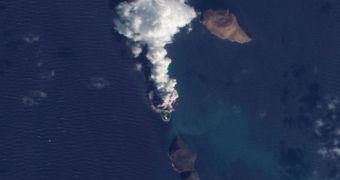Earlier this month, a strong volcanic eruption began taking place in the Red Sea. By December 19, fishermen reported seeing columns of lava rising as much as 90 feet (30 meters) above the waves. At this point, a new, barely-held-together island has appeared where there was only water before.
The area is not necessarily that well-traveled, so it took a while before news of the eruption reached scientists. NASA had its Aqua and Terra satellites observe the event with their respective Moderate Resolution Imaging Spectroradiometer (MODIS) instruments.
Observation sessions were carried out on December 20 and December 22. While the two spacecraft were imaging the area in high resolution, the Ozone Monitoring Instrument (OMI) on the American space agency Aura satellite was conducting chemical measurements of the atmosphere.
The tool discovered rather high levels of sulfur dioxide, a chemical known for its ability to block sunlight from reaching Earth's surface, by reflecting it out into space. OMI data represented the conclusive evidence that a volcanic eruption was indeed taking place.
By December 23, the new island was already visible on satellite data. The Earth Observing-1 (EO-1) satellite's Advanced Land Imager (ALI) was able to collect natural-color images of the patch of land.
“The volcanic activity occurred along the Zubair Group, a collection of small islands off the west coast of Yemen,” experts with the NASA Earth Observatory reported on December 28.
“Running in a roughly northwest-southeast line, the islands poke above the sea surface, rising from a shield volcano. This region is part of the Red Sea Rift where the African and Arabian tectonic plates pull apart and new ocean crust regularly forms,” they add.
It could be that the island will not endure. Formations of this type are usually made up of loose volcanic debris, which are especially sensitive to the action of sea waves. However, if new lava solidifies fast enough, it can allow the island to carry on.
Countries such as Tonga, Iceland and Indonesia also witnessed new island formation over the past few years, with several new patches of land springing up off their costs. The phenomenon is not uncommon in areas of intense tectonic activity.

 14 DAY TRIAL //
14 DAY TRIAL //